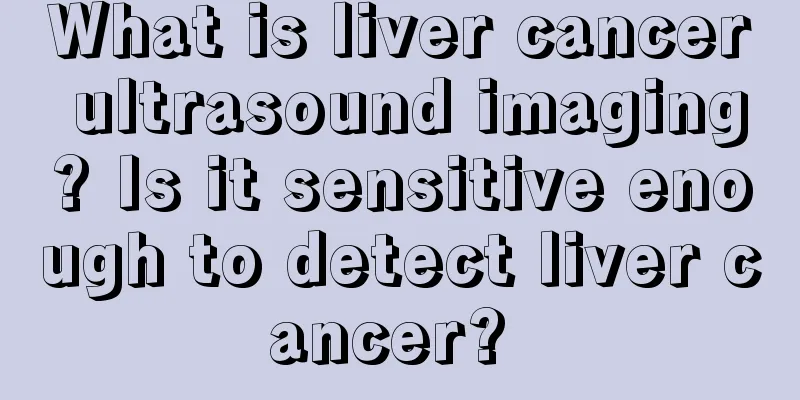What is liver cancer ultrasound imaging? Is it sensitive enough to detect liver cancer?

|
Imaging Knowledge Ultrasound Column Summary What is ultrasound contrast imaging for liver cancer? Ultrasound contrast imaging for liver cancer, also known as acoustic contrast imaging, is a technology that uses contrast agents to enhance backscattered echoes, significantly improving the resolution, sensitivity and specificity of ultrasound diagnosis. Ultrasound contrast imaging technology is often used in the diagnosis and differential diagnosis of liver tumors. The diagnostic process is as follows: after the space-occupying lesions of the liver are found on an ordinary ultrasound machine, ultrasound contrast agent is injected through a peripheral vein to observe the internal enhancement of the liver space-occupying lesion within a few minutes. Since the blood supply characteristics of malignant liver tumors are different from those of benign lesions, the difference in ultrasound enhancement can be used to diagnose and differentially diagnose malignant liver tumors. At present, ultrasound contrast imaging has been widely used in the detection and qualitative diagnosis of solid organ tumors. It is superior to conventional ultrasound and spiral CT in many aspects. Especially in the detection of sub-centimeter lesions below 1 cm, the diagnostic ability of ultrasound contrast imaging can be better than or at least have the same sensitivity as spiral CT. Compared with spiral CT and MRI (magnetic resonance imaging), ultrasound contrast imaging has more advantages, such as good safety, no allergic reaction, real-time, and relatively low examination costs. Ultrasound angiography can dynamically observe the dynamic changes of blood flow in the arterial phase, portal venous phase, and delayed phase of liver lesions, and diagnose and differentiate liver lesions based on the characteristic manifestations of various lesions. For example, hepatocellular carcinoma often presents a fast-in-fast-out performance, with complete enhancement in the early arterial phase and low echoes in the portal venous phase and delayed phase, which can be differentiated from benign lesions in most cases. Is ultrasound sensitive enough to detect liver cancer? Ultrasound examination is currently the most commonly used method for locating and diagnosing liver cancer, and is also the preferred method for screening liver space-occupying lesions. Hospitals generally use type B ultrasound examination, referred to as B-ultrasound. With the improvement of ultrasound equipment and the improvement of ultrasound technology, ultrasound examination can generally detect liver cancer with a diameter of more than 2 cm, and some experienced doctors can even detect liver cancer of 0.5 cm. The sensitivity of ultrasound examination is affected by many factors. However, the sensitivity of ultrasound examination is greatly affected by factors such as the size, location, echo characteristics, instrument resolution and the experience of the examiner. According to clinical statistics, the detection rate of ultrasound examination for hepatocellular carcinoma with a diameter less than 2 cm is 46%~95%, and the detection rate for 2~3 cm is 82%~93%, but the detection rates for hepatocellular carcinoma with a diameter less than 1 cm and metastatic liver tumors are 13%~37% and 20%, respectively. Ultrasound detection of liver cancer has blind spots There are also certain blind spots in ultrasonic detection of liver cancer. For example, the liver area under the diaphragm will be severely attenuated by ultrasound due to the influence of lung gas, which may cause liver cancer in this area to be easily missed. For patients with obese body or fatty liver, ultrasound will also be significantly attenuated, and the sensitivity of detection will also be affected, making it easy for missed diagnosis or misdiagnosis to occur. In addition, due to the real-time dynamic characteristics of ultrasound, the experience level of the examining physician also has a great impact on the sensitivity of liver cancer detection. The ultrasound contrast imaging technology currently being developed makes up for this deficiency of conventional ultrasound and can significantly improve the resolution, sensitivity and specificity of ultrasound diagnosis. |
Recommend
Reasons for gaining weight after quitting smoking
Smoking is harmful to health, which is a slogan t...
Causes of enlarged pores on hands
For some people, they may think that pores may on...
Small airway lesions
Many people are diagnosed with "small airway...
What are the effects and combinations of various scented teas? The benefits of drinking various scented teas
Spring is here, the Yang energy rises, and it is ...
What is the function of Cordyceps mycelium
In fact, the health benefits of Cordyceps myceliu...
How long can a patient with swollen feet in the late stage of gallbladder cancer live
Gallbladder cancer is not rare. It is more common...
What should I do if my body is too cold?
There are many reasons that cause the body to be ...
The standard of good soy sauce
Soy sauce is one of the most common condiments an...
Anxiety and heart rate
People often say that people who love to laugh wi...
What are the traditional Chinese medicine prescriptions for treating lung diseases
There are many types of lung diseases, including ...
What shoes are good to wear on rainy days?
Generally, unless there is an emergency, we will ...
What kind of cold is it that causes headache and stuffy nose
There are many types of colds, including colds, h...
What is the normal sperm count for a man?
As we all know, if women want to get pregnant suc...
Can nasal CT detect nasopharyngeal cancer?
Nasopharyngeal carcinoma is not unfamiliar to peo...
Homemade whitening cream
As people's aesthetic awareness improves, man...









